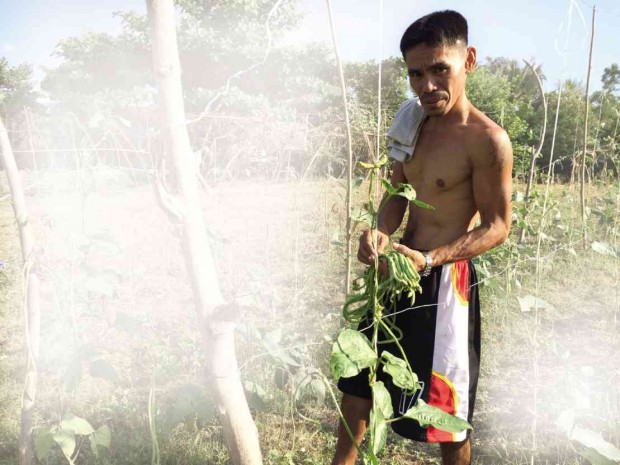Drought dries up Zamboanga veggie farmers’ income

CIRILO NOYNAY, a vegetable farmer in Zamboanga City, shows his “stressed out” string beans. The city has been suffering from a severe shortage of water as a result of El Niño. JULIE S. ALIPALA
CIRILO Noynay’s 61-centimeter-long (2-foot-long) string beans variety could hardly grow to its length.
“I have water dedicated for string beans because this gives me better income,” Noynay said as he tries to salvage some vegetables from poles that were once covered with healthy leaves.
But Noynay was able to harvest only four bundles worth P40 from his garden.
“That’s how it is—P40 weekly compared to last year when I got as much as 100 bundles every other day,” he said.
Annaliza Pabayos, a 41-year-old vegetable grower, said her vegetables “are too stressed out that my eggplant can only grow 5 cm (2 inches), and my peppers’ skin is getting old quickly.”
Article continues after this advertisementPabayos said she could hardly harvest 10 kilograms of vegetables from her farm.
Article continues after this advertisement“Last year, I got more than 100 kg, which was worth P2,000,” she said.
Pabayos complained that she had to spend P200 to fuel her water pump “to suck up water from the river to her vegetable farm.”
“Even grasses that give morning moisture are gone,” she said.
Diosdado Palacat, the city agriculturist, said the dry spell had been sucking up all the “little water, moisture and nutrients,” affecting the growth and fruiting of the vegetables and crops.
“The root systems of cereals and vegetables are very shallow—around 5 to 7 inches (13-18 cm). Grasses have also dried up, depriving food for the livestock,” Palacat said.
“It is so hot that every living thing within the agro-ecosystem is affected. The temperature is very hot that water disappears immediately,” Palacat said.
The City Agriculture Office reported that as of Jan. 8, crops on 372 hectares have been damaged, affecting 233 farmers who lost 1,674 metric tons of rice worth P7.4 million.
“Farmers planted rice last December when water was still flowing. In one month, the water was gone,” Palacat said.
The declaration of a state of calamity over the city may not immediately address or save the dying rice farms.
Palacat said the declaration could help farmers rescue “early maturing crops like tomato, rice, pepper and okra.”
Financial assistance, and the distribution of seedlings, will be provided to farmers heavily affected by the drought. Calamity funds will also be used for cloud seeding.
But Pabayos appealed to the city government to refrain from cloud seeding as “it kills all the leafy crops.”
“If they really want to help the farmers, they must look at irrigation systems for areas known to produce crops,” Pabayos said.